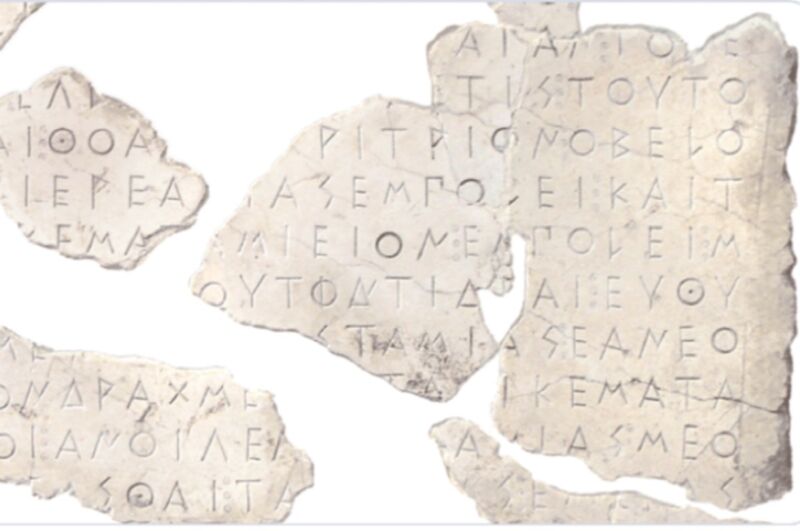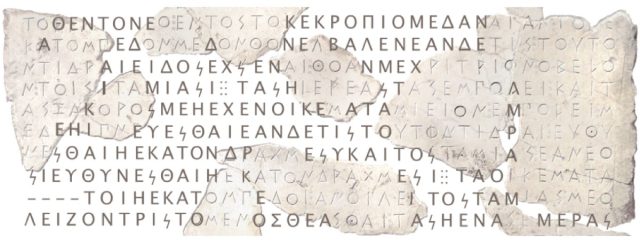
Google DeepMind has collaborated with classical scholars to create a new AI tool that uses deep neural networks to help historians decipher the text of damaged inscriptions from ancient Greece. The new system, dubbed Ithaca, builds on an earlier text restoration system called Pythia.
Ithaca doesn't just assist historians in restoring text—it can also identify a text's location of origin and the date of creation, according to a new paper the research team published in the journal Nature. In fact, Ithaca has already been used to help resolve an ongoing debate among historians about the correct dates for a group of ancient Athenian decrees. An interactive version of Ithaca is freely available, and the team is making its code open source.
Many ancient sources—whether they be written on scrolls, papyri, stone, metal, or pottery—are so damaged that large chunks of text are often illegible. Determining where the texts originated can also be a challenge, since they have likely been moved multiple times. As for accurately determining when they were produced, radiocarbon dating and similar methods can't be used since they can damage the priceless artifacts. So the daunting and time-consuming task of interpreting these incomplete texts falls to so-called epigraphists who specialize in those skills.
As the folks at DeepMind wrote in 2019:
One of the issues with discerning meaning from incomplete fragments of text is that there are often multiple possible solutions. In many word games and puzzles, players guess letters to complete a word or phrase—the more letters that are specified, the more constrained the possible solutions become. But unlike these games, where players have to guess a phrase in isolation, historians restoring a text can estimate the likelihood of different possible solutions based on other context clues in the inscription—such as grammatical and linguistic considerations, layout and shape, textual parallels, and historical context.
To help speed up the process, DeepMind's Yannis Assael, Thea Sommerschield, and Jonathan Prag collaborated with researchers at the University of Oxford to develop Pythia, an ancient-text restoration system named after the high priestess who served as the Oracle of Delphi by delivering the pronouncements of the god Apollo.

The researchers' first step was converting the Packard Humanities Institute (PHI) database—the largest digital collection of ancient Greek inscriptions—into machine-actionable text they called PHI-ML. That amounted to about 35,000 inscriptions and more than 3 million words from the 7th century BCE through the 5th century CE. Next, the researchers trained Pythia (with both words and the individual characters as inputs) to predict the missing letters of words in those inscriptions. Pythia was trained to use the pattern-recognition capabilities of deep neural networks.
When faced with an incomplete inscription, Pythia produced as many as 20 different possible letters or words that might fill in the gaps, as well as the confidence level for each possibility. It was up to the historians (i.e., the "domain experts") to sift through those possibilities and make a final determination based on their subject matter expertise.
The team tested the system by comparing Pythia's results on completing 2,949 inscriptions with those of Oxford graduate students in epigraphy. Pythia's output had a 30.1 percent error rate, compared to 57.3 percent error rate for the students. Pythia was also able to complete the task much more quickly, requiring just a few seconds to decipher 50 inscriptions, compared to two hours for the students.
And now Assael and his cohorts are back with Ithaca. In addition to the text restoration capability, Ithaca makes predictions about the geographical attribution of incomplete inscriptions. The probability distribution over all possible predictions is helpfully visualized on a map, "to shed light on possible underlying geographical connections across the ancient world," the team wrote in an accompanying blog post. For chronological attribution, Ithaca produces a distribution of its predicted dates between 800 BCE to 800 CE.

Testing revealed that Ithaca on its own is able to achieve 62 percent accuracy in the restoration of damaged text, compared to 25 percent accuracy for human historians. But the combination of man and machine boosts the overall accuracy to 72 percent, which Assael et al. believe demonstrates "the potential for human-machine cooperation" in the field. As for attributing inscriptions to their original location, Ithaca can do so with 71 percent accuracy and date the inscriptions to within 30 years.
Ithaca has already had the chance to demonstrate its usefulness to historians in a test case involving a set of Athenian decrees that have been at the center of a dating controversy. Historians had previously pegged the dates of the decrees to no later than 446 BCE. That assessment was based on certain letterforms (known as the Attic three-bar sigma) that the Athenian bureaucracy used during this period. After 446 BCE, the Athenians switched to an Ionic four-bar sigma for its decrees.
This was the standard dating methodology for Athenian inscriptions until other historians began to question its assumptions, particularly since several decrees dated this way seemed to conflict with the historical accounts of Thucydides. These historians uncovered evidence that the Attic letterform had continued to be used in official documents long after 446 BCE. They concluded that the dates of many of these decrees should be earlier—around 420 BCE. Ithaca predicted a date of 421 BCE, very much in keeping with that conclusion.
reader comments
48